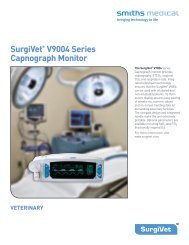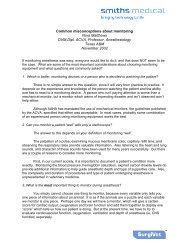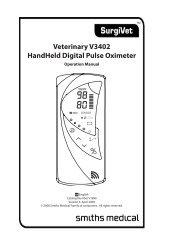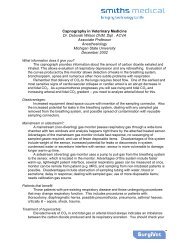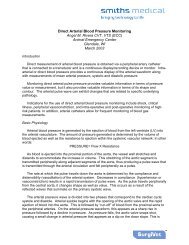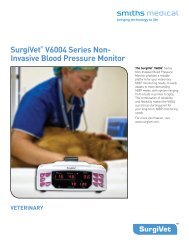Surgivet® V1030 Hand-Held Pulse Oximeter
Surgivet® V1030 Hand-Held Pulse Oximeter
Surgivet® V1030 Hand-Held Pulse Oximeter
You also want an ePaper? Increase the reach of your titles
YUMPU automatically turns print PDFs into web optimized ePapers that Google loves.
Chapter 4: Operating Instructions<br />
Attaching the Sensor to the Patient<br />
To attach the sensor to the patient:<br />
1. Choose the appropriate sensor. See sensor table for additional information.<br />
2. If using a reusable sensor, clean or disinfect the sensor per Cleaning or Disinfecting the Sensors<br />
section in this chapter. ( 7 Disposable sensors are for single-patient use and do not require<br />
cleaning or disinfecting.)<br />
3. Check the sensor and oximetry cable for damage and integrity. See Checking the Sensor and<br />
Oximetry Cable section for additional information.<br />
4. Attach sensor to the patient.<br />
WARNING! Prolonged use or the patient’s condition may require changing the sensor site<br />
periodically. Change sensor site and check skin integrity, circulatory status, and<br />
correct alignment at least every 4 hours.<br />
WARNING! SpO 2 measurements may be adversely affected in the presence of high ambient<br />
light. Shield the sensor area (with a surgical towel, for example) if necessary.<br />
WARNING! Dyes introduced into the bloodstream, such as methylene blue, indocyanine<br />
green, indigo carmine, patent blue V (PBV), and fluorescein, may adversely<br />
affect the accuracy of the SpO 2 reading.<br />
WARNING! Optical cross-talk can occur when two or more sensors are placed in close<br />
proximity. It can be eliminated by covering each site with an opaque material.<br />
WARNING! Significant levels of dysfunctional hemoglobins, such as carboxyhemoglobin<br />
(with CO-poisoning) or methemoglobin (with sulfonamide therapy), will affect<br />
the accuracy of the SpO 2 measurement.<br />
WARNING! Tissue damage may result from overexposure to sensor light during<br />
photodynamic therapy with agents such as verteporphin, porfimer sodium,<br />
and metatetrahydroxyphenylchlorin (mTHPC). Change the sensor site at least<br />
every hour and observe for signs of tissue damage. More frequent sensor site<br />
changes/inspections may be indicated depending upon the photodynamic<br />
agent used, agent dose, skin condition, total exposure time or other factors.<br />
Use multiple sensor sites.<br />
Choosing the Sensor<br />
WARNING! Use only SpO 2 sensors and cables supplied with, or specifically intended for use<br />
with, this oximeter. Use of sensors not intended for use with this device may<br />
cause inaccurate readings.<br />
WARNING! Incorrectly applied sensors may give inaccurate readings. fRefer to the<br />
sensor insert for proper application instructions.<br />
Choose the appropriate sensor from the following chart. Select the sensor based on the patient’s<br />
size, available application site, attachment method and other pertinent clinical information.<br />
f See the sensor’s instruction insert for detailed attachment methods and other important<br />
information.<br />
Veterinary <strong>V1030</strong> <strong>Hand</strong>-<strong>Held</strong> <strong>Pulse</strong> <strong>Oximeter</strong> Operation Manual 4-7


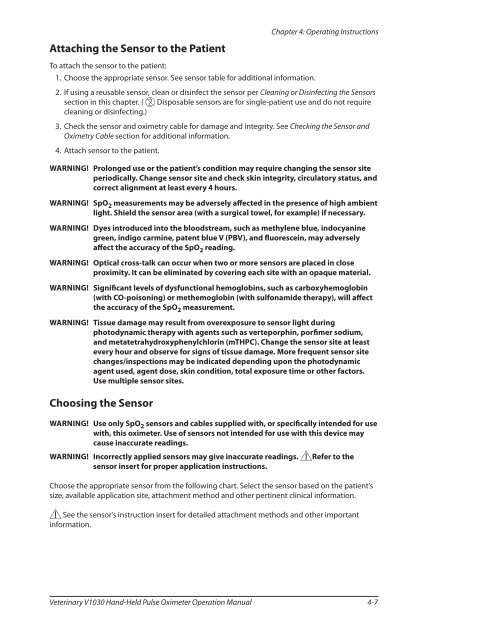
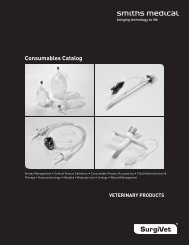


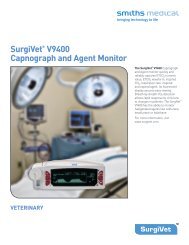
![Redemption Form [PDF] - SurgiVet](https://img.yumpu.com/37386077/1/190x245/redemption-form-pdf-surgivet.jpg?quality=85)
![Redemption Form [PDF] - SurgiVet](https://img.yumpu.com/37386066/1/190x245/redemption-form-pdf-surgivet.jpg?quality=85)
